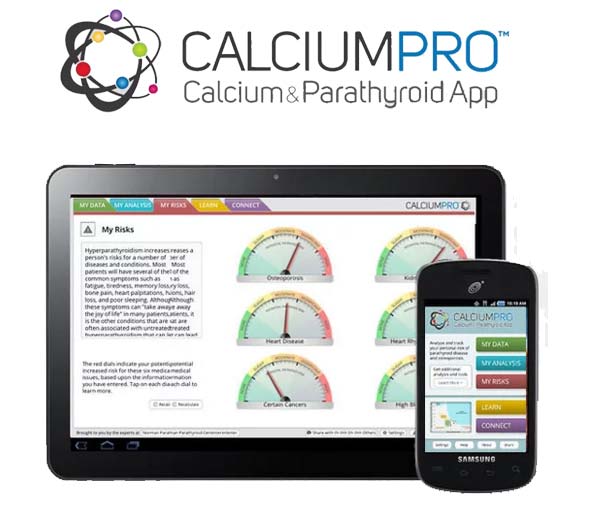Top 4 Mistakes Made By Doctors When Diagnosing Hyperparathyroidism

Primary hyperparathyroidism is a disease where one or more of our four parathyroid glands becomes hyperactive. This results in high calcium levels, which over time leads to a number of significant health problems in addition to causing a constellation of symptoms that can significantly affect quality of life.
In most cases, making a diagnosis of primary hyperparathyroidism is relatively simple, but we see mistakes made all the time which lead to delaying the diagnosis and, in some cases, completely missing it. This is a serious problem, as hyperparathyroidism is a destructive disease that damages your organs and can make you feel terrible and needs to be treated.
Here, we will discuss the most common mistakes we see doctors make with a hyperparathyroidism diagnosis.
Top 4 Mistakes Made When Diagnosing Hyperparathyroidism:
- Not recognizing the meaning of low vitamin D levels in primary hyperparathyroidism
- Believing that high parathyroid hormone (PTH) levels are required for a hyperparathyroidism diagnosis
- Using a scan to help diagnose hyperparathyroidism
- Believing every lab value must be out of range to make a hyperparathyroidism diagnosis
Let’s take a closer look at these common mistakes to see why doctors make them. Understanding these errors can help you avoid having them made in your case.
Mistake #1 Made When Making A Hyperparathyroidism Diagnosis: Not Recognizing the Meaning of Low Vitamin D Levels
Something we see repeatedly, is when a patient is found to have high calcium levels by their doctor, often PTH and vitamin D levels will be checked as well. The PTH will be elevated and the vitamin D level will be low. They will suspect hyperparathyroidism but will proceed to give the patient high doses of vitamin D to “rule out vitamin D deficiency” as the cause for their abnormal lab values.
Why is vitamin D low with a hyperparathyroidism diagnosis?
Parathyroid hormone has only one job in your body – to raise calcium levels in your bloodstream back to normal when they get too low. PTH acts in three main ways to accomplish this, one of which is to facilitate absorption of calcium from your gut from dietary sources. It does this by acting as an enzyme in a reaction converting vitamin D to its more active form. The active form of vitamin D then facilitates absorption of calcium from your intestines into the bloodstream, helping to raise your calcium levels.
When you have a parathyroid adenoma making too much PTH, you end up converting too much vitamin D to its active form, lowering the less active form. The less active form is what your doctor typically checks as a measure of general vitamin D levels, and it is essentially always low in patients with a hyperparathyroidism diagnosis.
How does vitamin D deficiency affect PTH levels?
The reason doctors get confused here is because in patients WITHOUT a hyperparathyroidism diagnosis but who have significantly low vitamin D levels, PTH levels can become elevated. This is to compensate for the lower rates of vitamin D-mediated absorption of calcium from the intestines by increasing the activity of the other two methods PTH has for raising calcium levels in your bloodstream.
While both patients with a hyperparathyroidism diagnosis and those with vitamin D deficiency have low vitamin D levels, ONLY PATIENTS WITH HYPERPARATHYROIDISM CAN HAVE ELEVATED CALCIUM LEVELS. Patients with vitamin D deficiency always have low or low-normal calcium levels. This is why giving a patient with high calcium, high PTH, and low vitamin D levels “to rule out vitamin D deficiency” before making a diagnosis of hyperparathyroidism makes no sense, and can actually be harmful. Do not let you doctor make this mistake with you! The following graphic summarizes the difference in calcium and vitamin D levels between vitamin D deficiency and primary hyperparathyroidism.
Learn more about vitamin D and hyperparathyroidism here.
Mistake #2 Made When Making a Hyperparathyroidism Diagnosis: Believing that PTH levels have to be above the normal range to make the diagnosis
Another mistake we commonly see is a doctor will see that their patient has high calcium levels. They astutely check PTH levels and find that they measure within the “normal” range. Because the PTH level is not above the normal range they conclude that their patient does not have a hyperparathyroidism diagnosis and the subject is closed. This mistake prevents many patients with this disease getting the treatment they need.
How can PTH levels be “normal” in patients with a hyperparathyroidism diagnosis?
While many patients with hyperparathyroidism do indeed have frankly elevated PTH values, about 25-30% of patients with the disease have PTH values that measure within the normal range. How is this possible? Well, if you understand how the parathyroid glands work it makes sense.
Your parathyroid glands only secrete PTH when your calcium levels in your blood are too LOW. The only job PTH has is to raise your calcium levels back to normal. If your calcium is measuring HIGH for some reason and your parathyroid glands are working properly, they have no reason to secrete PTH and this level will be very low. Therefore, if your calcium is elevated and your PTH is in the normal range but not VERY low, this is still abnormal and indicates a hyperparathyroidism diagnosis.
How low can PTH levels get in patients with high calcium levels and still mean they have a hyperparathyroidism diagnosis?
In a perfect world, based on the above concept if your calcium is high and you have normal parathyroid glands your PTH should be theoretically be ‘zero” – normal parathyroid glands should completely shut down when your calcium is too high. In biology, however, things are rarely that black and white, and we can see some low levels of PTH in patients with high calcium levels not related to hyperparathyroidism – but usually not higher than the 20 range. PTH values in the 30s or above with high calcium levels, in most cases, indicate a hyperparathyroidism diagnosis that requires treatment. This graphic summarizes the normal and abnormal relationships between calcium, PTH and vitamin D.
If you have high calcium levels and your doctor checks your PTH levels, but tells you that your PTH levels are “normal” and you have nothing to worry about – make sure you ask what exactly that PTH level is. If it is in the 30s or above you most likely have hyperparathyroidism and should be treated!
Mistake #3 Made When Making a Hyperparathyroidism Diagnosis: Relying on the results of scans to make the diagnosis
Patients with lab values that make their doctors suspect a hyperparathyroidism diagnosis often get imaging studies as part of the “work-up”. There are several types that can be obtained, but the most common are ultrasound scans of the neck and a nuclear medicine test called a sestamibi scan. We frequently see doctors order these imaging tests in patients they think have hyperparathyroidism, but when the scan does not show an abnormal parathyroid gland, they tell their patient that “everything is OK”.
Imaging tests play NO ROLE in making a hyperparathyroidism diagnosis!
Whether or not a scan – ultrasound, sestamibi scan, CT scan, MRI – shows an abnormal parathyroid gland has absolutely no bearing on deciding if a patient has a hyperparathyroidism diagnosis. This is because the imaging technology currently available is simply not very good at “seeing” abnormal parathyroid glands.
Normal glands are really small – ranging between the size of a grain of rice and kernel of corn – and while parathyroid adenomas are certainly larger than this, we are still talking about fairly small structures that can be difficult to discern from other tissues on imaging tests. Sestamibi – the chemical used in nuclear medicine “parathyroid” scans can be taken up by parathyroid cells, but this does not always occur for reasons we do not understand. Overall, the sensitivity for these various imaging tests for detecting abnormal parathyroid glands in patients with this disease is not much better than 50%. This means about half the patients who have this disease have imaging tests that show ABSOLUTELY NOTHING.
So then why do we get these imaging tests?
Despite their poor sensitivity, these imaging tests DO have a role in the treatment of patients with hyperparathyroidism (just not a diagnostic one). For example, ultrasound of the neck performed before parathyroid surgery can detect nodules in the thyroid gland that should be addressed, or can alert us to the presence of a parathyroid tumor hiding INSIDE the thyroid gland. These are some of the reasons we perform a neck ultrasound on all our patients before their surgery.
We perform a sestamibi scan before each of our surgeries, even though in many cases no abnormal parathyroid glands can be seen. This is done because even when they do not “show” the abnormal parathyroid gland, the parathyroid tissues still absorb some of the chemical and allow us to functionally evaluate each gland during the operation – to determine if they are making a normal amount of hormone or too much hormone. This can be really helpful when making a decision about whether or not to remove a subtly abnormal gland during surgery.
If your labs are suspicious for hyperparathyroidism, do not let your doctor tell you everything is OK because a scan does not show anything! Learn more about the use and pitfalls of sestamibi scans here.
Mistake #4 Made When Making a Hyperparathyroidism Diagnosis: Believing that EVERY lab value must be out of range
We take care of many patients who have significant delays in being diagnosed and consequently treated for hyperparathyroidism. It is frustrating to see this given how much successful parathyroid surgery improves their health and quality of life. One of the reasons for this delay is the incorrect assumption that every time a patient’s calcium and PTH levels are checked, they must be abnormal to make a hyperparathyroidism diagnosis. One set of labs will be suspicious for hyperparathyroidism; the doctor will have the patient repeat the labs to confirm their suspicion; but the follow up labs look normal. They assume everything is OK and the subject is closed.
Can you have normal labs with a hyperparathyroidism diagnosis?
The answer is – yes you absolutely can. To be clear – not ALL of you labs can be normal with a diagnosis of hyperparathyroidism. However, it is not unusual for both calcium and PTH values to fluctuate into and out of the normal range in patients with this disease. While normal parathyroid cells secrete hormone according to strict biochemical “rules” and do so in a predictable pattern, parathyroid tumor cells do not follow the “rules”. PTH secretion from these abnormal cells can be very high one minute and much lower the next minute. This can cause both your PTH levels and your calcium levels to fluctuate, so that depending on when exactly the blood is drawn, calcium and PTH levels can be elevated or lower in the normal range.
What should be done if one set of labs looks suspicious for parathyroid disease and a follow up set of labs looks normal?
If this occurs, your doctor should check several more sets of these same lab values over the course of a few weeks/months. This will give a clearer sense of the overall pattern of a patient’s parathyroid function. If more than one set of labs looks suspicious even with one or more fairly normal sets of labs mixed in, then a hyperparathyroidism diagnosis is very likely.
These are errors we see over and over again made by doctors evaluating their patients for a hyperparathyroidism diagnosis. This delays diagnosis and treatment for this disease in many cases, and in some cases prevents it completely. Do not let this happen to you!
Read more about the diagnosis of hyperparathyroidism here, or learn more on our advanced diagnosis page here.
Additional Resources:
Read more on the Parathyroid blog.
Check out our sister surgeons at the Clayman Thyroid Center, the Scarless Thyroid Surgery Center and the Carling Adrenal Center. We are now united under one roof, operating at the Hospital for Endocrine Surgery.




